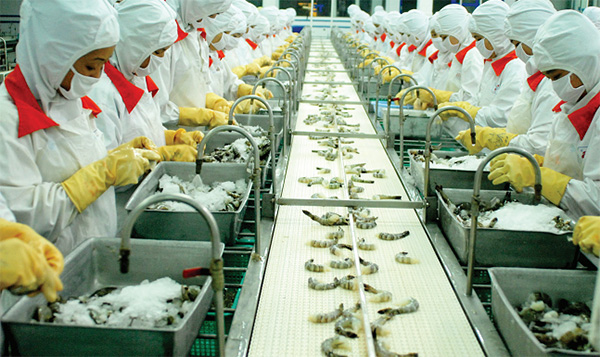Trade is one of the keystones of the comprehensive partnership between the US and Vietnam. Bilateral trade has grown from nothing on the day Vietnam and the US normalised their diplomatic ties nearly 21 years ago to $41 billion in 2015. Minister of Industry and Trade Tran Tuan Anh shared his thoughts with VIR’s Thanh Huong on the two countries’ current relations and future co-operation prospects, particularly after the enforcement of the Trans-Pacific Partnership (TPP).
 |
The US, the world’s largest economy, has become Vietnam’s second largest trade partner. Vietnam’s exports to the US grew to $33.5 billion in 2015, and are forecast to increase strongly in the years to come. On what grounds are the expectations for future growth based?
Vietnam’s exports to the US are expected to continue growing in the future based on many factors:
First, the US, which has a population of more than 300 million people and a GDP per capita of $56,000, has high spending habits. The US imports more than $2.2 trillion worth of goods annually.
Second, Vietnam’s export items to the US are very diverse, ranging from food, garments and footwear to furniture and spare parts for mobile phones, for which the demand continues to increase significantly.
Since Vietnam and the US normalised relations, and especially after the Bilateral Trade Agreement (BTA) took effect in late 2001, Vietnam’s export turnover to this market has continued to expand.
Currently, Vietnam is the top ASEAN exporter to the US. Experts forecast that once the TPP takes effect, bilateral trade will increase significantly.
The reduction in tariffs and technical barriers would be a major advantage for Vietnamese firms to compete with other exporters that would not be able to enjoy these incentives when shipping similar products to the US.
The TPP would also help Vietnam attract more foreign investors to the country, thus helping it increase its export capacity (and particularly its exports to the US) in terms of both quantity and quality.
A strong rise in foreign direct investment (FDI) in Vietnam over the past few years has set this trend.
Aside from these advantages, with 15 years of experience shipping goods to the US, Vietnamese exporters are well aware of the market’s anti-dumping taxes and anti-subsidy and technical barriers as well as its spending habits.
This knowledge will prove useful in the future, helping them tap into the US market’s potential.
 |
| Breaking into the US market will require increased quality and hygiene standards from local manufacturers |
The BTA marked a milestone in the two countries’ relationship. What has Vietnam gained from this agreement over the past 15 years?
The BTA has greatly expanded bilateral trade over the past number of years, conferring the most-favoured-nation (MFN) status on Vietnam.
More importantly, the BTA held special significance for Vietnam, because it was signed as the nation was making its first steps towards global economic integration.
It was one of the first free trade agreements allowing Vietnam to gain a first-hand understanding of major concepts in international trade, such as service market access, rules of origin, and intellectual property.
The BTA also had a great impact on Vietnam’s legal system, prompting the country to build a legal framework that merged international commitments with local laws.
New trade categories and commitments under the BTA provided the basis for Vietnam to issue and amend many legal documents to facilitate the agreement’s enforcement.
Finally, the BTA was a catalyst for Vietnam’s economy to start on the path towards global integration, which has become a major goal for the Vietnamese government.
Overall, Vietnam has made great achievements since the signing of the BTA. This has proven the Party and state’s sound leadership in guiding the country towards global economic integration.
The TPP will add to the momentum in deepening the partnership between Vietnam and the US. Which sectors, in your view, will see a breakthrough in the two countries’ trade and investment co-operation when the TPP comes into force?
Independent economists agree that the TPP will likely bring enormous benefits to its member economies. The deal is expected to expand economic ties between Vietnam and the US, especially in exports and investment.
For export activities, the immediate removal (or gradual reduction) of import duties on TPP member country products will likely boost trade between the US and Vietnam.
In particular, the TPP is expected to create favourable conditions for Vietnamese export items such as garments, footwear, seafood, and agricultural products to access the US market, while the US’ electronic products, machinery, and some agricultural products would also enjoy more preferential tax treatment, thus allowing the goods to enter the Vietnamese market at cheaper prices.
Regarding investment, the TPP will likely help Vietnam attract more foreign investors, including those from the US. Despite the presence of numerous US-backed projects in Vietnam, these projects have not met their true potential.
Once the TPP takes effect, more US investors are expected to seek investment opportunities in Vietnam, thus raising the US’ position as one of the country’s largest foreign investors.
In addition, as a member of the TPP, Vietnam would benefit from new supply chains (especially in electronic spare parts production).
Today, many powerful international groups, including Intel and Microsoft, have invested in Vietnam with a goal of turning the country into one of their main hi-tech production bases.
Joining the TPP would help accelerate this process, and create favourable conditions for Vietnam to enter global production chains and develop its own hi-tech and electronics sectors.
This is considered a huge opportunity to further strengthen economic and investment co-operation between the US and Vietnam.
The TPP is expected to afford favourable conditions for Vietnamese exports. What should Vietnamese firms do to tap into these opportunities and increase their exports to the US?
The TPP opens up a plethora of opportunities for Vietnamese firms to boost exports to TPP member countries, which make up 40 per cent of global GDP, and 30 per cent of global trade. These nations include huge markets like the US.
However, Vietnamese firms, which have small production scales, out-of-date technology, difficulties raising capital, and lack of experience, would face stricter requirements in many areas, including the quality of goods, hygiene, environmental protection, labour, and technology.
Therefore, in order to make the most of the benefits arising from the TPP and overcome hurdles, Vietnamese firms should be more aware of the following issues:
First, Vietnamese enterprises should get a good overview of the TPP and equip themselves with information about the commitments made by the US and Vietnam, particularly the agreement’s preferential tariffs for export items with a comparative advantage and future potential.
Currently, the text of the agreement has been put on the MoIT’s website at http://www.tpp.moit.gov.vn.
This is a useful channel for anyone interested in learning more.
Vietnamese businesses should also change their outdated mindset.
They should consider competition as a driving force for innovation and development, and restructure their business and production activities to meet rules of origin so as to enjoy import duty reductions on exports destined for the US market.
They should also increase the quality of their products to satisfy the demands of US customers, actively join trade promotion activities in the US, and pay due attention to building a trademark or brand name for themselves and for their products.
Vietnamese firms should consider co-operating with one another to boost exports in the long term.
In fact, with their small production scale, Vietnamese exporters have yet to meet the large demand of this market, which is home to huge distribution systems.
Local businesses need to find solutions to take advantage of these conditions.
Last but not least, domestic enterprises need to create partnerships with US firms, which would enable them to tap into the US companies’ strong financial and technology capabilities, and allow local companies to join regional and global supply chains.
In order to help Vietnamese firms make the most of opportunities from the TPP and increase exports to the US, the MoIT will continue to promote the TPP among the local business community and will organise more trade promotion programmes.
It will also keep up to date on changes in the global market to provide adequate support for businesses.
The US market has strict requirements on goods and services, which many Vietnamese firms fail to meet. What should authorised Vietnamese agencies and businesses do to increase exports to the US in a sustainable manner?
Apart from tariffs, technical barriers are useful tools to control and limit imported goods.
Once tariffs are gradually removed, developed countries will increase their requirements on quality and standards.
Trade restrictions such as anti-dumping taxes, anti-subsidy taxes, or safeguard measures will also be used more frequently to protect their markets.
Vietnamese firms should therefore continue to improve their production management to lower product prices, while paying more attention to increasing product quality to meet technical and hygiene requirements.
They should also boost the application of technology, improve product models, and diversify designs to create global brands.
Moreover, as a good labour and production environment is a necessary condition for enjoying tariff preferences under the TPP, local businesses should carefully take note and make sure their practices comply with requirements.
How have US investors in Vietnam helped solidify the US-Vietnam partnership? What should Vietnam do to improve its business climate in a healthy and transparent manner to attract more investors from the US?
Trade between Vietnam and the US has increased significantly over the past few years. In 2015, the US was Vietnam’s biggest export market with a turnover of $33.5 billion, accounting for 20.7 per cent of Vietnam’s total export turnover.
Meanwhile, Vietnam’s imports from the US reached $7.8 billion during the same year. From 2011-2015, Vietnam’s export turnover to the US rose 18.6 per cent a year on average.
This increased bilateral trade can be attributed to the major contributions of US firms operating in Vietnam.
The US now ranks seventh among the 101 countries and territories investing in the country, with projects valued at $15 million on average, higher than the $14.3 million average for FDI projects overall. US firms have invested in 17 out of 21 economic sectors in Vietnam, with the majority focusing on hospitality and food services.
US investment has given a boost to Vietnam’s economic growth, job creation, human resource training, and labour restructuring.
It has also made a great impact on other economic sectors, prompting them to enhance their technology application and operational efficiency.
Economic relations between Vietnam and the US have developed rapidly in many sectors, and are expected to continue growing well into the future.
To draw more US investors to Vietnam, the government needs to take bold measures to improve its business climate by creating more favourable conditions, increasing transparency through administrative reform, and improving the quality of its human resources as well as the protection of intellectual property.
VIR